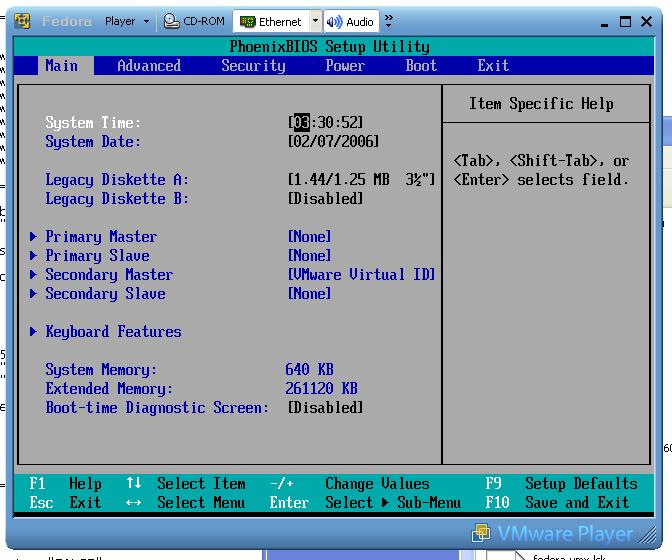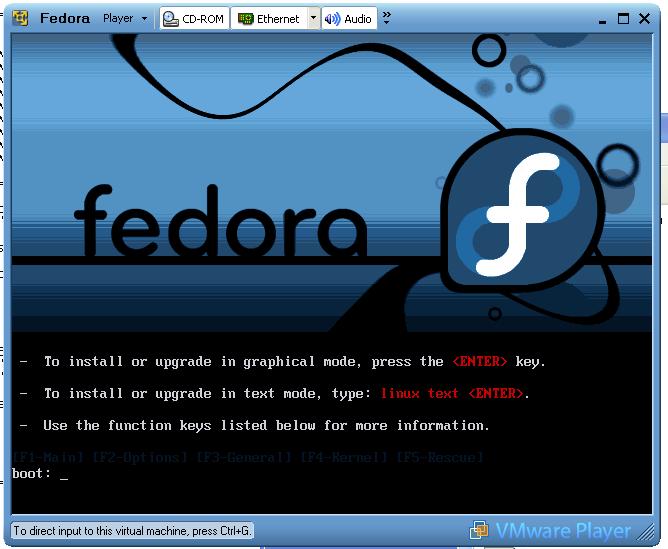Linux on Windows without the Dual-Boot
By EricMesa
- 4 minutes read - 793 wordsVMware has relased their VMware Player player for free. This product acts as a virtual machine (as opposed to an emulator) and is, therefore, supposed to give you much faster speeds than a program like QEMU. You could use it to run Windows on Linux or Linux on Windows. I will go over putting Linux on Windows. First go to http://www.vmware.com/products/player and download the player. Then download the Browser-Appliance. Of course, the easiest way is to download a Linux image which has already been created for you. They have Debian, Fedora, Suse, Ubuntu, and a few others. However, as I already have CDs of Fedora Core 5 test 2 downloaded, I don’t want to waste bandwidth (and time) downloaded the vmx image. Therefore, I will go over a slightly harder way, but, according to the PDF at this site, it doesn’t appear to be that hard.
So I downloaded VMware Player and the Browser Image file (which I have read is a stripped down ubuntu) and rebooted. I then extracted the zip file for the Browser-Application. (The extraction seemed to take forever and choke up my computer a bit, but it finally happened) I then made a copy of this folder. I then renamed all the files to fedora.
I opened the VMware Configuration File in notpage and changed
ide1:0.fileName = “cdrom-raw”
scsi0.0.fileName=“fedora.vmdk”
uncommented ethernet0.connectionType = “bridged”
comment ethernet0.connectionType = “nat”
nvram = “fedora.nvram”
I double-clicked my fedora file and ubuntu loaded. I didn’t get to tell it to boot from the CD-ROM fast enough, so I told it to reboot. The computer was VERY responsive! I see what happened, I had to click into the virtual machine first, it wasn’t recognizing my F2 presses!

I went to the boot screen and used the minus key to move CD-ROM device to the top. Then exited, saving changes. This time it still missed my CD-ROM, what could be hapening? Perhaps I have it in a drive that the computer is not recognizing. So I move the disc down from my DVD-ROM to my DVD+-R and reboot. That still ignored it!
I change ide1:0.startconnected = “TRUE” (it was false before)
That didn’t work so I change deviceType to “auto detect”
success!!!
This must be how they get screenshots of the installation and grub images!

It’s 10:39 as I begin my installation…
I’ve only given the virtual machine 264 MB of ram, but it runs amazingly fast - can’t even tell it’s emulated! I pick my applications for installation. I decide not to go crazy this time and install everything. I just want to get the darned thing working so that I can have the coolness of a working VMWare install.
So why would you want to do this? There are a few reasons.
-
Dual booting can fsck up computers. That is true! It happened to my brother’s brand new Alienware computer when I tried to dual boot Fedora Core 2 for him. The boot tables got all messed up and we had to reformat and reinstall everything!
-
Dual booting requires me exiting my current OS! This can also be annoying! Of course, how feasible it is to run both a VMware emulated Linux boot and a Windows boot depends upon how much memory you have. The more memory you allocate to Linux, the less you have for Windows. Still, I like the idea of being able to run them boot without so much as a reboot.
-
You test Linux distributions for fun or for work. (Although, if you do it for work, you probably already use VMware, QEMU, Zen, or one of the other options) If you are constantly going to be installing different flavors of Linux on your computer, it can become extremely annoying. Each time you install a new OS, some configuration could render your computer useless. With VMware, none of your other OS installations have to know about each other! They are all each contained in their own little world. Another advantage is that you can use the stable version of an OS in one virtual machine while testing the unstable version in another. In fact, you could COPY all of your virtual files from your stable OS into another folder and voila! you can upgrade to the testing version while still keeping your working stable version! It’s like magic!
I’m sure there are other reasons, although I can’t think of them right now. Aha! If you have your children run Windows in a Virtual Machine (or Linux or BSD), then any mistakes they make won’t mess up your real installation. If the “computer” becomes infested with viruses, just delete the virtual image and start again!
About 30 minutes left for the installation to complete, I’ll see you on the other side.